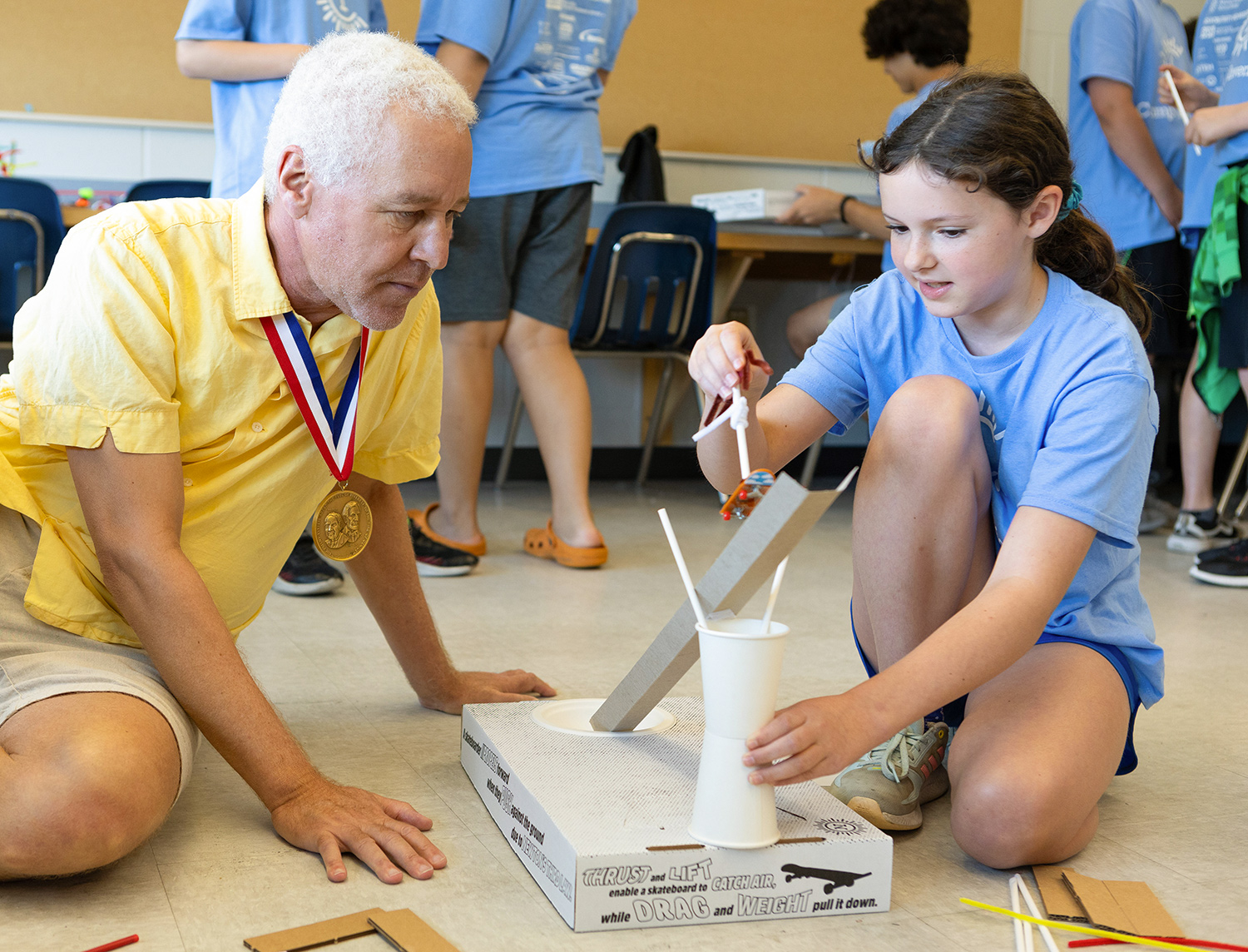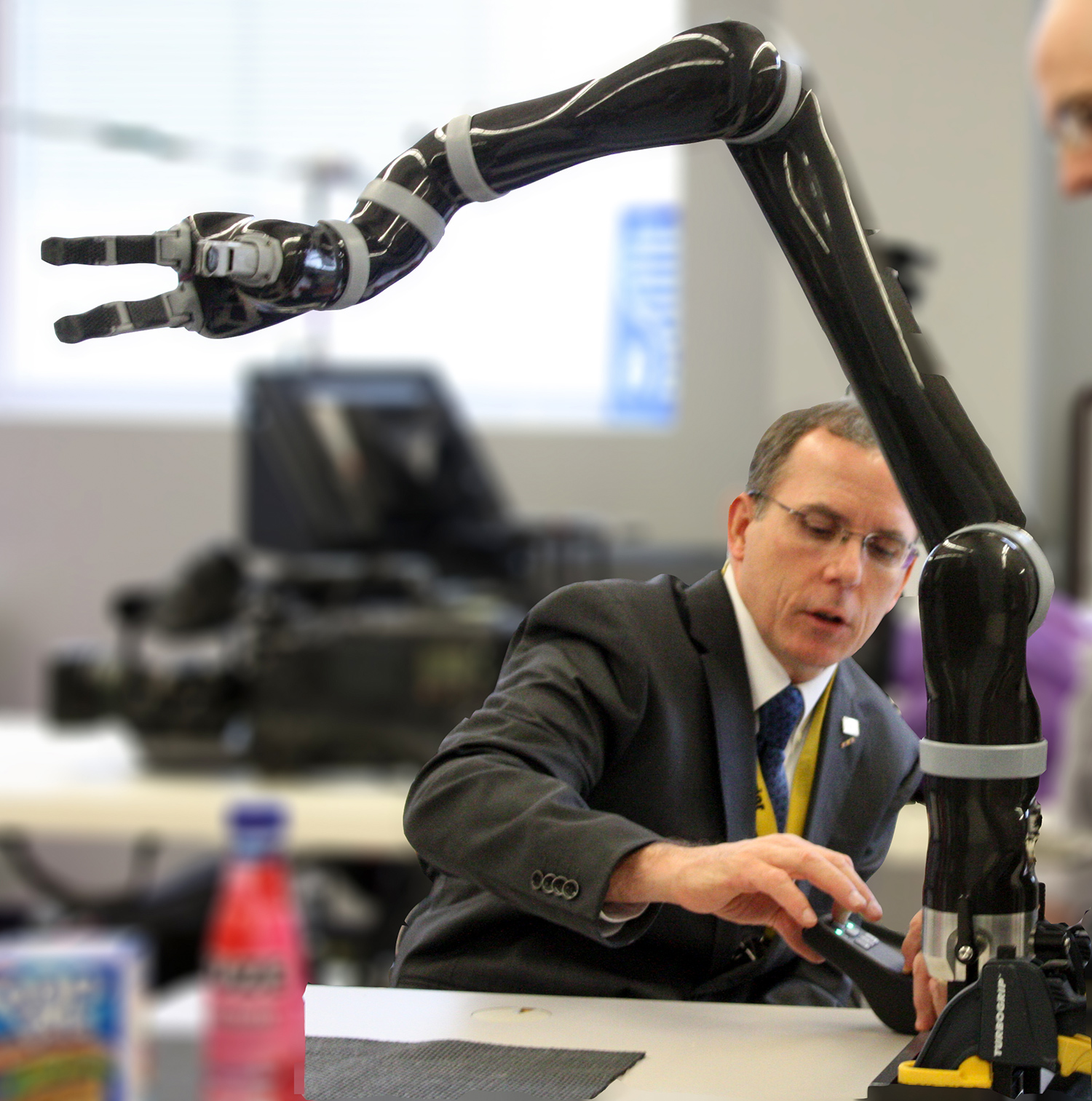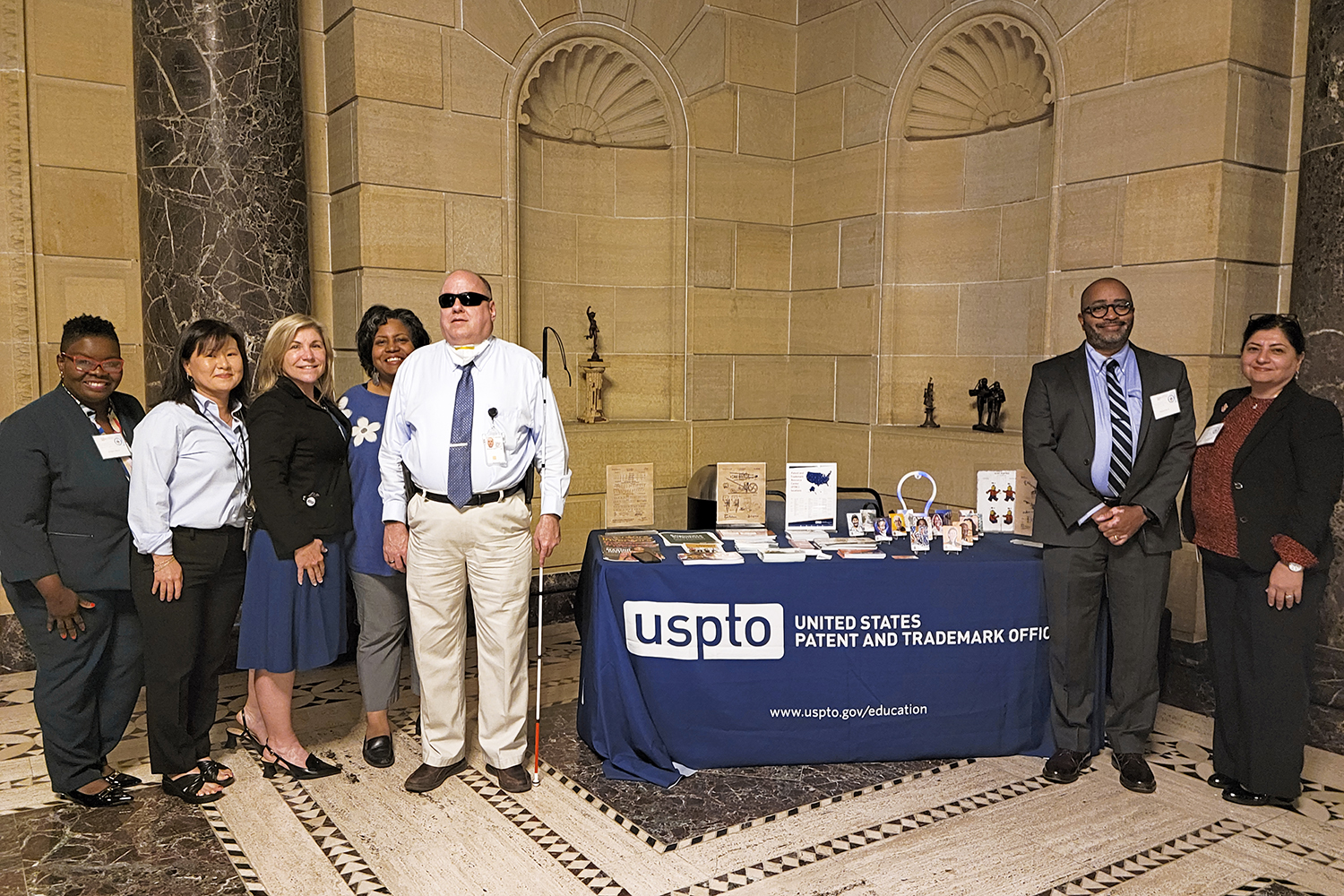
https://www.uspto.gov/blog/changing-world-through-innovation-celebrating-and-empowering-people-disabilities
Content Reproduced verbatim from the Website of the United States Patent & Trademark Office as permitted under their Terms of Use.

A young Camp Invention participant shows Dr. Robert Bryant, a prolific inventor and NASA scientist with a visual disability, a miniature finger-board skate park that she designed, engineered, and built. (Photo courtesy of Debbie Leanne Portraits)
October is National Disability Employment Awareness Month. The USPTO’s focus on inclusive innovation is to help lift up innovators, including the 29% of American adults with disabilities. Through our National Strategy for Inclusive Innovation, among other initiatives, we’re working to make USPTO resources more accessible to people with disabilities. I joined Commerce Secretary Gina Raimondo and other leaders at the Department of Commerce’s first-ever National Disability Leadership Summit on September 17 to discuss how the USPTO’s important work in this area reflects the Biden administration’s focus on empowering people of all ability levels.
During the month of October, we’re celebrating National Disability Employment Awareness Month to help raise awareness of all the contributions that people with disabilities bring to their workplaces, the innovation ecosystem, and to society as a whole. The USPTO is here to help all creators – current and aspiring – transform their innovative ideas into products and services that benefit society and grow the U.S. economy. Our focus on inclusive innovation is to help lift up innovators from all backgrounds, including the 29% of American adults with disabilities.
Through key projects and initiatives, including our recently released National Strategy for Inclusive Innovation, we are working to make USPTO resources more accessible to people with disabilities so they can better navigate the intellectual property system and protect their innovations. I was honored to join Commerce Secretary Gina Raimondo and other leaders at the Department of Commerce’s (DOC’s) first-ever National Disability Leadership Summit on September 17 to discuss how the USPTO’s important work in this area reflects the Biden administration’s focus on empowering people of all ability levels. As Secretary Raimondo noted in her remarks at the Summit, in the 34 years since the Americans with Disabilities Act became law, “we’ve made incredible progress” but “there is so much more to do” to meet accessibility goals. “We have to make sure that all Americans, including Americans with disabilities, have access to the opportunities that we’re creating.” I couldn’t agree more.
Every innovation tells a story about the unique experiences and backgrounds of the innovator, often with the goal of improving the lives of others in similar situations. It’s important to share stories of differently abled inventors so more individuals living with disabilities can be inspired to blaze similar trails and change the world for the better.
One example of a truly inspiring innovator with a disability is Dr. Rory Cooper.

Dr. Cooper with one of the groundbreaking inventions developed at his lab, an “assistive manipulator,” or robotic arm, with an interface that can be controlled by a person’s brain instead of being physically manipulated.
Dr. Cooper has dedicated his career to lifting up people of all abilities. He is a distinguished professor at the University of Pittsburgh and a Department of Veterans Affairs (VA) senior scientist. He co-founded an initiative with his university and the VA called the Human Engineering Research Laboratories (HERL). At HERL, he leads a team of fellow inventors who have received 25 U.S. patents related to wheelchairs, robots, and wearable instruments.
Dr. Cooper’s athletic pursuits and military career were impacted when he was involved in a bicycle accident that left him paralyzed. Despite his injuries, Dr. Cooper’s creative spirit remains strong. “The wheelchair I use, the adaptive vehicle I use, the home modifications I use, they all allow me to be productive and creative and contribute to society,” he says. “What’s important is to create a world where everyone belongs and everyone can contribute.”
Whether in his lab in Pittsburgh or as part of his public speaking and mentorship around the world, Dr. Cooper’s story has inspired countless others to pursue their own innovations.
Another inspiring innovator is Dr. Robert Bryant, who sees innovation in a unique way, in part due to his visual disability. Dr. Bryant was born with oculocutaneous albinism type 2, which results in monocular vision. To describe what it’s like, Dr. Bryant shared that “for [him], the world is like going to a movie theater,” because it’s like he “looks at the world, [but is] not in the world.” He experienced challenges from a very early age. To this day, important tasks, like reading, take extra effort.
Dr. Bryant is a problem solver and holds 30 patents. His ability to see opportunities missed by others led him to develop a thin electrical-insulation material known as the Langley Research Center-Soluble Imide (LaRC-SI) polymer. Because he knew the polymer had value, Dr. Bryant kept working with it after it wasn’t chosen for the original aerospace project for which it was created. He also wanted his work and its funding to benefit the public, and not be forgotten.
One of the valuable properties associated with the LaRc-SI polymer is that it’s biologically inert, meaning the human body doesn’t attack it. This unique trait led Dr. Bryant to pivot his work, instead focusing on medical applications. The polymer now extends the life of pacemakers implanted in humans, helping hundreds of thousands of people worldwide avoid having to undergo additional surgeries to replace their existing devices.
Dr. Bryant is one of many inventors whose belief in themselves, science, and societal progress spurred them to invent miraculous products to solve for the needs of people with many types of disabilities. We invite you to interact with and learn from our stories on the successes of these notable innovators. These individuals have worked tirelessly to knock down barriers for others by blazing trails with their patented technological advances:
- The late Ralph Teetor, blinded by a childhood accident, honed his other senses to create numerous innovations related to the automobile industry, including the first cruise control device.
- Chieko Asakawa, who was blinded in a swimming pool accident as a teenager, creates accessible products for visually impaired people.
- Temple Grandin, who couldn’t speak for the first several years of her life, became a well-known inventor, author, and advocate for treating livestock humanely.
- William J. Warner, who suffered a spinal cord injury as a teenager, is an Oscar-winning inventor who created digital editing software and mobility applications.
Our country succeeds when everyone with dreams of innovation has an equal chance to show the world what they can do. Working together with other agencies and leaders in the private sector, we’re striving to make those dreams a reality for all.

USPTO employees gather around the agency’s table on September 17 at the National Disability Leadership Summit in Washington, D.C., at the Department of Commerce. (Photo by Sahar Javanmard/USPTO)
At the USPTO, we are working to bolster the diversity of our workforce, in part through hiring employees with all abilities. More than 8% of the USPTO workforce identifies as an individual with a disability. If you’d like to learn more about career opportunities at our agency, please visit the Join Us page on our website.
If you know of innovators of any ability we should highlight through our Journeys of Innovation storytelling series and other channels, please email us at [email protected]. We look forward to hearing from you!
